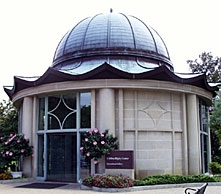Christina St. Germain gave the first talk in ring 3, which was entitled: An Investigation into the Historic Painted Finishes of the Senate Reception Room (S-213), U.S. Capitol, Washington, DC: The Ceiling, Enframements, and North Lunette.
Christina St. Germain, Conservator of Paintings at Artex Conservation Laboratory, discussed Artex’s findings from an in-depth study of historic painted finishes on the ceiling, enframements, and north lunette in the U.S. Capitol Building’s Senate Reception Room. She discussed the history of the room and the artists responsible for the room’s decoration. The methods used by Artex to reveal and document the original historic finishes were touched on, as well as, selected results shared.
Two artists were responsible for the painted finishes in the Senate Reception Room: Constantino Brumidi, the Artist of the Capitol, and Emmerich Carstens, Foreman of Decorative Painters. The elements of the room focused on in this study were the decorative painted areas by Carstens in between the murals and frescoes painted by Brumidi. The original paint layers (added by Carstens) were applied between 1858 and c. 1872, and have been identified as an oil and protein dispersion paint (Wolbers, 1997).
In 1915, there was an explosion in the northwest corner of the room, which damaged the north wall, north lunette, and northwest window casement. Two documented restoration campaigns occurred following this incident: one in 1916, locally repairing the damaged area, and a second in 1924-32 including a full repainting of all decorative painted elements in the room, which accounts for much of the current painted finishes seen today. The only exception to this is selective repainting in vault and north lunette by Preservar between 1995 and 1997.
Overall, the Ceiling, Enframements, and North Lunette project was a massive undertaking. In total, about 375 paint exposures were made and about 100 paint samples were taken by Artex conservators. All samples were mounted as cross-sections in order to view the paint stratigraphy, and comparisons were made with the corresponding exposures and historical documentation to determine original painted finishes.
St. Germain then discussed selected results of the Artex project, including two original painted finishes found on the ceiling, one found on the window and door enframements, and two found on the north lunette. In the vault (north ceiling), a dark grayish olive painted field between gilded flora and fauna was examined. A lighter grayish olive base color with gilded dots was found to be the original finish, covered by several paint layers. In the dome (south ceiling), the current moderate pink-toned trompe l’oeil moldings surrounding 60 octagonal coffers were found to have been originally a deeper grayish red in tone.
Today, the window and door enframements only depict two different finishes – a pale yellow, and a grayish brown. In most of the pale yellow areas, a light greenish gray faux marble finish was found.
Lastly, the North Lunette was discussed. From this study, it is now known that this area once looked very different from how it appears now. The original Greek key borders, grayish greenish yellow fields, and central grayish yellow brown field were likely first covered over due to the aforementioned 1915 explosion and then repainted in 1924-32 with the currently visible red curtains, abbreviated Greek key border, and large dark grayish yellow field.
St. Germain ended with recommendations for the future, which are to replicate the original finishes found using a modern reversible paint due to the difficulty in making exposures and condition issues noted in the original finishes. Original paint colors revealed in this study have been cross-referenced to modern paint swatches to assist in replication. The Artex exposures made in this study will also remain visible so one can compare the replication with the original painted finishes.
Summary by Pamela Johnson
